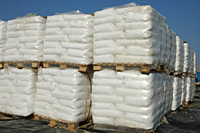
P.O. BOX 030040
Fort Lauderdale, FL, 33303
Phone: 954.332.2290
Fax: 954.332.2296
Email: Sales@ContinentalSteel.com
Website: www.continentalsteel.com

Titanium Dioxide, also referred to Titania, has a molecular formula of Ti02 and this mineral compound – a white colored, odorless solid - is available in three different forms. Rutile titanium dioxide is the most common naturally occurring form followed by the anatase form but titanium dioxide can also be produced synthetically.
Titanium dioxide is produced from either ilmenite, rutile or titanium slag. The titanium pigment is extracted by using either sulphuric acid (sulphate process) or chlorine (chloride route). The sulphate process employs simpler technology while the chloride route produces a purer product.
Titanium Dioxide - classified by CAS No. 13463-67-7 - is mined as a mineral in magmatic rocks. It is non-flammable, non-explosive and titanium dioxide is the most widely used pigment because of its brightness and refractive index.
Over 4 million tons of titanium dioxide are used worldwide every year for a wide array of common applications like paint, coatings, plastics, papers, ink, food (it’s often used to whiten skim milk and to enhance the flavor of nuts, seeds, soup and beer), medicine and toothpaste.
Titanium Dioxide is also used in cosmetics and skin care products as a pigment, in sunscreen and sunblock as a thickener to protect the skin from ultraviolet light.
Titanium Dioxide, believe it or not, is used to mark the white lines on the tennis courts at Wimbledon. Indeed, titanium dioxide accounts for 70% of the total production of pigments worldwide because “titanium white,” as it’s often called, is one of the whitest materials known to exist on Earth. In fact, titanium dioxide is even more reflective than diamonds!
